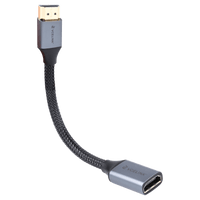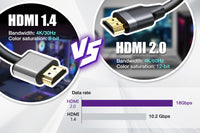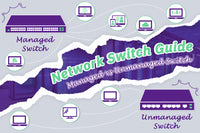Contents
Modern home entertainment systems can be more complex than ever and keeping various devices connected seamlessly can be challenging for many homeowners. Imagine setting up your living room for the perfect movie night with Blu-ray players and streaming devices but only to find your TV lacks enough HDMI ports. Or consider displaying the same content across multiple screens in different rooms but struggling with complicated cabling. HDMI splitter and HDMI switch can easily solve these problems, but it’s essential to know their differences. In this article, we will dive into the comparison between HDMI splitters and switches!
What is HDMI Splitter?
HDMI splitter is an efficient solution if you want to send the signal of a source device to multiple displays. Also known as an HDMI duplicator, it is used to connect one source device to two or more HDMI-supported displays like TVs and other monitors. HDMI splitters allow you to enjoy the same content on different displays. The HDMI splitter usually comes in different variants such as 1*2 (1 input, 2 outputs), 1*3, and 1*4. Setting up the HDMI splitter is very easy. Just connect your game console or Blu-ray player directly to display devices, power on devices, and then adjust the settings as needed.
HDMI splitters can be either active or passive. Passive HDMI splitters only have the basic function of splitting HDMI signals and are limited by distance and signal loss. On the other hand, active HDMI splitters, equipped with an additional power source, can split signals over a long distance. To achieve the best performance of HDMI splitter, it is recommended to use high-quality HDMI cables.
What is HDMI Switch?
Different from HDMI splitters, HDMI switches are used to transfer multiple input signals to a single input. HDMI switch helps connect multiple HDMI signals, such as PlayStation 4, streaming TV, or Xbox to a single display device, such as a TV or other displays. HDMI switch is an effective solution to expand the number of HDMI inputs available for your TV.
Manual switches and automatic switches are two common types. As the name suggests, manual switches require users to press the physical button or switch on them. Simple configurations make them more affordable. Automatic switches have built-in sensors to achieve the functionality of automatic switches and additional features like remote control, which provides much convenience for users.
Most HDMI switches support high definition including 4K Ultra HD and sometimes even 8K along with various latest audio formats. That means HDMI switches can provide users with optimal audio and video experience. Besides, some additional features like remote control, automatic switching, and picture-in-picture mode also offer added convenience for daily lives. HDMI switches are also compatible with HDCP (High-bandwidth Digital Content Protection) to play protected content.
(Note: A HDMI KVM switch is a more complex device than a HDMI switch. HDMI KVM switch is named after keyboard, video, and mouse. Users are allowed to use a single keyboard, video display monitor, and mouse to control several computers via HDMI KVM. It features multiple computer controls, multi-user computer access, and multiple OS controls, which make it suitable for data centers to control a large number of devices. It can also be used in office desktop switching, medical imaging, broadcast, etc.)
Key Differences between HDMI Splitters and HDMI Switches
As mentioned above, the key difference between an HDMI splitter and an HDMI switch is its functionality. The HDMI splitter has one input and multiple outputs, while the HDMI switch features multiple inputs and one output. Besides the difference in function, they also differ in other aspects.
HDMI splitters are easy to use with their plug-and-play style, but they lack the capability to control individual screens if you want to keep one screen off and one screen on. Additionally, if your displays have different resolutions, it can only support the lowest resolution among them. HDMI switch allows you to choose which source devices to display on TV, offering added convenience and control.
HDMI splitters and switches usually have different labels. For example, an HDMI splitter can be marked with “1*3” or “1*4”, meaning one input and three or four outputs, respectively. An HDMI switch can be labeled with “3*1” or “4*1”, indicating three or four inputs and one output.
HDMI Splitter vs. HDMI Switch: Which to Choose?
Both HDMI splitters and HDMI switches are great tools to simplify the cabling and offer convenience for users. But how to choose between the two in different scenarios? Simply speaking, it depends on your number of source devices and display devices. If you have one source but many displays, HDMI splitter suits for you. If you own multiple sources but only one display, the HDMI switch suits you more.
For example, if you have various monitors including TVs, projectors, and 4K displays and you enjoy watching TV programs in your free time, the HDMI spitter would be suitable for you to split the same content from one source device like streaming TV on your different devices. Thus, you can watch it freely on different devices.
In another scenario, you are a gaming maniac and always collect different gaming consoles. But you only have one display for gaming. Instead of buying more screens, an HDMI switch can make it possible to connect all of your source devices to a single display. You require an HDMI switch to switch different game signals you like rather than replug the cable and reconnect to your display and gaming console.
Besides entertainment, HDMI splitters and switches are widely used in business and educational scenarios. For instance, in a business meeting, an HDMI switch can make everyone’s PC displayed on one projector for their presentations. In some training sessions, an HDMI splitter enables everybody to see the same content on their computers.

What is HDMI Matrix?
There is another device called HDMI matrix that combines the features of HDMI splitter and switch. An HDMI matrix enables multiple HDMI signal sources to be connected and then split different signals to multiple display devices. Users can switch source devices easily instead of unplugging and replunging. Without switching cables or devices constantly, it provides convenience for users.
Common specifications of HDMI matrixes are 4*4 (4 inputs, 4 outputs), 8x8, 16x16, etc. They are used for various scenarios. For example, if you want to establish a home theater, an HDMI matrix can help you level up it. You can choose to watch content from streaming devices, computers, or Blu-ray players on the TV or your projector for your like. In a media meeting room, an HDMI matrix allows you to display contents from different PCs on multiple displays if you need to.
Besides the combined features of the HDMI switch and splitter, the HDMI matrix has additional features including handling different HDMI resolutions. It can support multiple video signal types like 1080p, 4K, and 8K, and different audio formats like Dolby Digital, DTS, Dolby Atmos, and DTS: X.
Final Thoughts
HDMI splitters and HDMI switches have different functions. Simplifying HDMI cabling and enhancing seamless connectivity, both of them provide convenience for people’s lives, whether for gaming consoles, streaming boxes, home entertainment, or business and education.
FAQs
Are HDMI splitter and HDMI switch interchangeable?
No, they serve the opposite purpose and are complementary rather than interchangeable.
What should I consider when selecting an HDMI splitter?
You should consider the number of outputs, the resolution and refresh rate your device supports, HDMI versions, and HDCP compatibility.
Does the HDMI matrix cause latency?
HDMI matric can potentially cause latency and it can be affected by many factors such as cable length and quality and HDMI matrix quality.
For more information on this topic, you can keep up on our blogs. While VCELINK offers general and basic information for our customers and other visitors to the website, it’s not professional advice.






Be the first one to comment.
Leave a comment